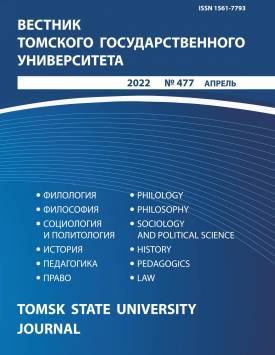A comparative analysis of English and German verbal idioms with the component “feather/Feder”
The study focuses on 56 English and German nominative-communicative (verbal) phraseological units, with the common etymologically related component feather/Feder as part of their composition. Mono- and bilingual dictionaries, both explanatory and etymological, serve as a source of research material which is characterized as chronologically heterogeneous. This principal prerequisite allows comparing people's common, typical features and reflecting inherent mentality characteristics. The research aims to (1) identify the degree of inter-lingual correlation between the selected idioms, (2) specify similarities and differences in their meaning, (3) fix universal and unique (national and cultural) particularities. The authors hypothesize that verbal idioms with an etymologically related component manifest a high degree of inter-lingual correlation. The applied inter-language approach facilitates the research material's classification for further elucidation of its structural and semantic proprieties, functions, national identities, whereas the cross-language approach enables the identification of phraseological correlation degree. At different research stages, the authors employ such methods as: the continuous sampling method, the distribution of idioms into structural and semantic groups, the analysis of definitions derived from lexicographical literature, the scaling method, the method of phraseological identification, the analysis of cultural background information, the etymological analysis, and others. The comparative analysis reveals a domination of the negative (pejorative) subjective evaluative component in both English and German investigated material. In contrast to German idioms, English idioms display a more discernible shift towards pejorative meanings. The existence of a comparatively considerable quantity of German phraseological units of the group writing performance and sleep constitutes a significant cross-lingual difference. Conversely, English idioms exhibit a wider range of meanings throughout 25 phraseological-semantic groups (versus 19 in German). Totally, classified in 3 groups, 10 units out of 56 are determined as cross-lingual equivalents (CLE): full CLE (2), close CLE (6), quasi-equivalents (2). According to the grading scale, the obtained quantitative data unveil a marked (the second smallest) degree of inter-lingual correlation, equal to 17.85%, while the vast majority of idioms (82.15%) are non-equivalent. Therefore, the research hypothesis for a high-level degree has been rejected. Overall, the analysis of the selected sampling of idioms demonstrates their high-level figurativeness due to the symbolic nature of the common component and its figurative potential, embodied in unique national images.
Keywords
somatism, cross-linguistic correlation, subjective evaluative component, cross-lingual phraseological equivalent, nominative-communicative phraseological unit, national and cultural component, phraseological-semantic groupAuthors
| Name | Organization | |
| Khrabrova Valentina E. | National Research University Higher School of Economics - Saint Petersburg | stefankhrabrova@mail.ru |
| Sergaeva Yulia V. | Herzen State Pedagogical University of Russia | sergaeva@gmail.com |
References

A comparative analysis of English and German verbal idioms with the component “feather/Feder” | Vestnik Tomskogo gosudarstvennogo universiteta – Tomsk State University Journal. 2022. № 477. DOI: 10.17223/15617793/477/5
